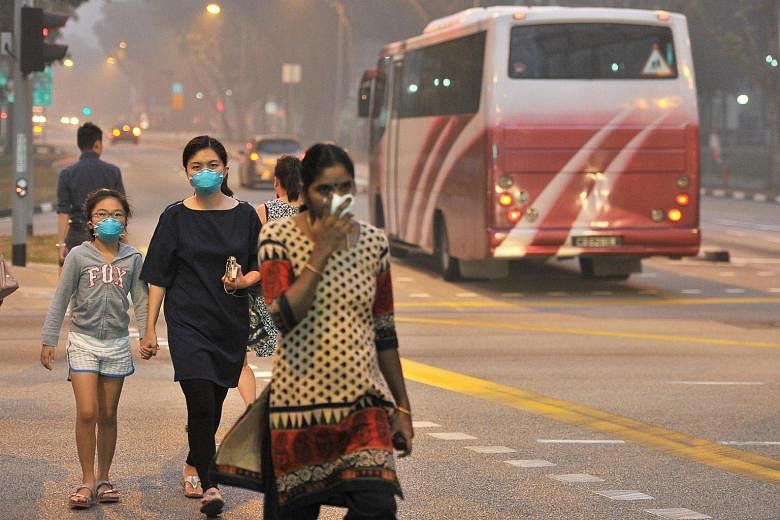This story was first published on The Straits Times website on Oct 7, 2014.
Air quality in Singapore on Tuesday (Sept 15) continues to hover within the unhealthy range. The three-hour PSI, an indicative reading not tied to health advisory, was 107 at 10am, after crossing the 200-mark on Monday night.
Here's a list of 10 things to note about the haze:
1. What is PSI?
PSI, which stands for Pollutant Standards Index, is computed based on 24-hour average of PM2.5 concentration levels, among other pollutants. PM2.5 is the dominant pollutant during haze episodes.
The ambient air in Singapore is monitored through a network of air monitoring stations located in different parts of the island.
The monitoring stations measure concentration levels of particulate matter (PM10), fine particulate matter (PM2.5), sulphur dioxide, nitrogen dioxide, ozone, and carbon monoxide. These six pollutant parameters determine the PSI.
2. What is the difference between the 24-hour PSI and three-hour PSI?
The 24-hour PSI is based on readings taken over the past 24 hours. The three-hour PSI is based on readings taken in the past three hours.
The health advisory in Singapore is based on the 24-hour PSI. This is in line with the vast majority of studies on the health effects of short-term exposure to PM which have used the 24-hour measurements.
While there have been recent studies on sub-daily or shorter PM2.5 exposure, there needs to be more conclusive evidence before health advisories can be based on these readings.
3. Which PSI should I refer to if I want to decide what activities to avoid?
The public can use the three-hour PSI or 1-hour PM2.5 concentration levels to make adjustments to their daily activities. For example, if the three-hour PSI is high, you may wish to postpone strenuous outdoor activities such as jogging.
4. Why is it that the three-hour PSI readings during the smoke haze periods is at times low even when the visibility is poor?
The three-hour PSI is based on PM2.5 concentration levels averaged across three hours. As the hour to hour concentrations may be volatile, it may not correspond to what you may observe at that specific instant.
5. How is the PSI in the different regions of Singapore measured, and which one should I look at?
PSI is measured for five regions in Singapore: North, South, East, West and Central. The regions are based on town centres/areas:
North: Admirality, Kranji, Woodlands, Sembawang, Yishun, Yio Chu Kang, Seletar, Sengkang
South: Holland, Queenstown, Bukit Merah, Telok Blangah, Pasir Panjang, Sentosa, Bukit Timah, Newton, Orchard, City, Marina South
East: Serangoon, Punggol, Hougang, Tampines, Pasir Ris, Loyang, Simei, Kallang, Katong, East Coast, Macpherson, Bedok, Pulau Ubin, Pulau Tekong
West: Lim Chu Kang, Choa Chu Kang, Bukit Panjang, Tuas, Jurong East, Jurong West, Jurong Industrial Estate, Bukit Batok, Hillview, West Coast, Clementi
Central: Thomson, Marymount, Sin Ming, Ang Mo Kio, Bishan, Serangoon Gardens, MacRitchie, Toa Payoh
6. Is the N95 mask an adequate protection against haze?
Haze can contain fine particles that are 2.5 microns or smaller (PM2.5), and studies have shown that N95 masks do provide good protection against particle pollutants as they are at least 95 per cent efficient against fine particles that are about 0.1 - 0.3 microns.
But N95 masks work only if there is a good fit with the face of the wearer.
7. Can I reuse my N95 mask?
N95 mask can be reused, but should not be shared. It should be changed when it gets soiled or distorted in shape.
8. What about surgical masks? Are they useful?
Normal surgical masks can protect the wearer's nose and mouth from irritants in the air but are not effective in filtering fine particles.
9. What else can I do to reduce exposure to haze particles?
Some practical tips include:
- When the outdoor air quality appears to be worsening, close doors and windows
- Stay indoors and cut down on physical activities
- Wet-cleaning methods (e.g. mopping or wiping) generally do not produce dust (unlike dry-dusting or vacuuming) and can be used to remove settled dust
- Fans or air-conditioners may be used for air circulation and cooling. Portable air purifiers can help to further reduce the indoor particle level
10. What should I look out for when choosing a suitable air purifier?
Some air purifiers are labelled with a Clean Air Delivery Rate (CADR), which has three CADR numbers - one each for smoke, dust, and pollen. The smoke CADR is the most appropriate for haze pollutants.
An appropriate air purifier should have a smoke CADR number that is at least 3 times the volume of the room in cubic metre, or 1/12 of the volume of room in cubic feet. A larger CADR number means faster cleaning in an enclosed room.
There are many effective air purifiers without CADR rating in the market. Users should obtain from the manufacturer information that backs any claim on efficiency of removal of fine particles.
Source: National Environment Agency

